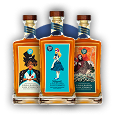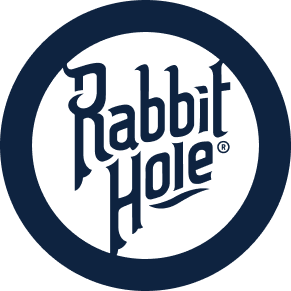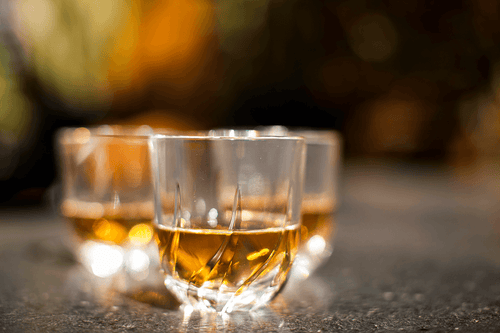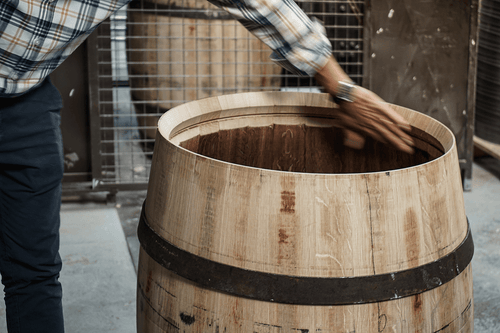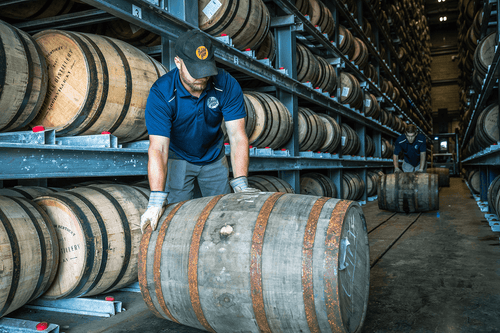Cavehill Four Grain Bourbon
CAVEHILL FOUR GRAIN BOURBON
RABBBIT HOLE DISTILLERY
Bourbon is typically made from a three-grain mash bill, and by varying the type and combination of grains, distillers can create a wide variety of flavors to give their bourbon a unique taste profile. But Rabbit Hole Distillery is pushing the boundaries even further by using four grains in their mash bill...
Cavehill – Award Winning Four Grain Bourbon
BOURBON MASH BILL
- 70% corn
- 10% malted wheat
- 10% malted barley
- 10% honey malted barley
Rabbit Hole is one of the most innovative distillers with their four grain bourbon "Cavehill Kentucky Straight Bourbon Whiskey." Four grain bourbon gives distillers like Rabbit Hole an almost infinite canvas to experiment with the ratio of the grains and grain types used. An ideally designed aging and malting process further influences the flavor of this one-of-a-kind bourbon.
Cavehill Four-Grain Bourbon
Rabbit Hole Distillery's Cavehill four-grain bourbon is a triple-malted bourbon whiskey made from a mash bill of 70% corn, 10% malted wheat, 10% malted barley, and 10% honey malted barley. This unique blend of grains gives the bourbon a delightful aroma with notes of spice, honey, and fresh apple. Your palate will pick up the complexities of the bourbon with its creamy flavors of orange, honey, mint, and hints of toasted grain, with a soft vanilla and custard finish.
Cavehill four-grain bourbon is aged for at least two years in new hand-crafted American white oak casks from the Kelvin Cooperage. Before charring, the barrels are slowly toasted over a wood fire for up to 20 minutes. Toasting brings out sugars from deep within the wood's fibers to mingle with the whiskey during aging and add to its complex flavor profile. At maturity, a maximum of 15 casks are blended to make Cavehill a truly small-batch bourbon.
What Is a Four-Grain Bourbon?
Most distilleries use a traditional three-grain recipe to make bourbon. By law, the mash bill must contain at least 51% corn, but the remaining 49% can be made up from any type of grain and in any ratio. Typically, in addition to the corn, distillers add rye, malted barley, and extra corn. Others use wheat in place of the rye.
Four-grain bourbon must be made according to the same strict regulations as any other bourbon. That means it must be:
- Produced in the U.S.A.
- Made from a mash bill of at least 51% corn.
- Distilled to no more than 160 proof (80% ABV).
- Be aged in new charred oak barrels.
- Barreled for aging at no more than 125 proof (62.5% ABV).
- Bottled at no less than 80 proof (40% ABV).
While there is no legally defined aging period for bourbon, it must be aged for at least two years to be labeled as straight bourbon.
Some distillers began experimenting with four-grain bourbon recipes. Instead of making a whiskey with rye or wheat as a secondary flavoring grain, they added both, using a mash bill of corn, rye, wheat, and malted barley in various percentages. The sweetness of the corn blends with the bold spicy and peppery flavors of the rye and the wheat's gentler grassy and earthy flavors.
For Cavehill four-grain bourbon, Rabbit Hole Distillery decided to go for a smoother, corn-rich blend with malted wheat, malted barley, and honey malted barley. All the secondary flavoring grains are carefully malted to increase the depth of flavors and create a unique and unmatched taste profile.
What's in a Grain?
The combination and ratio of grains are crucial to the flavor of every bourbon. At Rabbit Hole, the mash bill for Cavehill four-grain bourbon is made up of:
- 70% corn.
- 10% malted wheat.
- 10% malted barley.
- 10% honey malted barley.
By using three malted grains, Cavehill can be described as a four-grain triple malt bourbon that stands apart from other four-grain bourbons. The malting of grain is an ancient process that releases enzymes to aid the fermentation of barley. In other grains, such as wheat, malting helps to convert the starches into fermentable sugars.
The process “tricks” the grain into thinking it's in the ground and ready to grow. First, the grain is soaked in water, known as steeping, then allowed to dry and begin to germinate. At the point when it begins to sprout, the germination is quickly stopped by heating and drying the grain.
Corn is the backbone of bourbon, giving it the characteristic sweetness it's renowned for. In Cavehill four-grain bourbon, Rabbit Hole has increased the corn content from the legally required minimum of 51% to 70% to create a rich, sweet base.
Malted wheat is more often used in craft brewing and is common in German beers. For Cavehill, wheat adds grassy and earthy tones to the whiskey, and when malted, imparts gentle and creamy fruit notes.
Malted barley is needed in the mash bill to produce the enzymes that help convert the starch in the corn into fermentable sugars. The barley adds hints of toasted grain to the whiskey's flavor profile.
Honey malted barley is distinct from regular malted barley as it undergoes a different malting process that actually doesn't involve honey. During malting, oxygen flow to the barley is restricted, causing it to essentially “stew” itself. The process causes the malt bed to heat up, helping the barley develop sugars and rich malty and honey flavors.
Is Four-Grain Bourbon Better?
To paraphrase a British saying, there's no bad bourbon, just some that's better than others. Whether making three- or four-grain whiskey, each bourbon distillery uses different percentages of grain in their mash bill to create the signature flavor they want. This means that no two bourbons will taste the same, and the whiskey can even vary from batch to batch. By using four grains in a bourbon, distillers can create more depth and a complexity of flavors not necessarily found in three-grain bourbon.
With such diversity in bourbon profiles, the ones you choose to drink come down to personal preference. But Cavehill four-grain bourbon, with its three malted grains, is unique in the marketplace, and once tried, is never forgotten. In your local liquor store or bar, look for the distinctive Cavehill bottle from Rabbit Hole Distillery.














